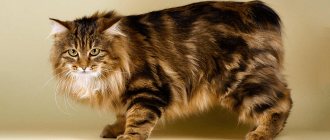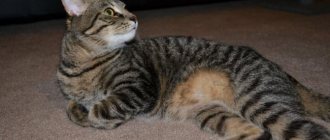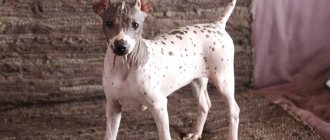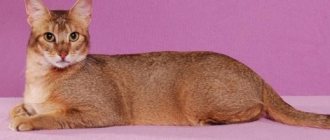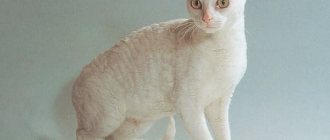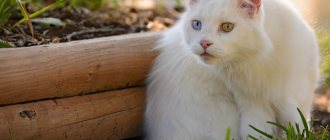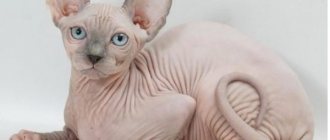Video
* We invite you to watch a video about the Himalayan cat . In fact, in front of you is a playlist in which you can select and watch any of 20 videos about a given cat breed by simply clicking on the button in the upper right corner of the window. In addition, the material contains quite a lot of photos. By looking at them you can find out what a Himalayan cat looks like.
Rate the material!
[Total votes: 1 Average: 5]
The Himalayan cat is a fairly large breed with long hair and a special color. Her large sky-blue eyes give her incredible charm. Despite its name, the animal has nothing to do with the Himalayas, being the result of long-term work by breeders from the USA. This beauty will not leave anyone indifferent. The cat is very affectionate and sociable, an ideal pet for any family.
Catering
Kittens (up to 6 months) and pregnant cats are fed at least 4 times a day, adolescents (from 6 months to one and a half years) - 3 times, older ones - 2 times. The owner chooses the food: natural dishes or dry and wet food. You can't mix them! It is allowed to use dry and wet food of the same brand.
Natural products
General nutrition rules:
- Check foods before giving them to your cat. Inspect meat and fish for parasites, do not skimp.
- Cats should not be fed fried food.
- Be sure to cut dense and hard food into pieces to prevent your cat from choking.
- Alternate foods. You cannot feed the animal only meat or only porridge.
The diet should include:
- Meat: rabbit, chicken, veal, lamb, turkey. Duck, quail, lamb and pork are prohibited: they are too heavy for a cat's stomach. It is allowed to give liver, hearts and ventricles. The meat is stewed, boiled or, after defrosting, doused with boiling water. Give daily.
- Fish (hake, salmon, trout, taimen, pink salmon) contains amino acids, lipids, magnesium and phosphorus, but you should not get carried away with it. Otherwise, the animal will have kidney problems. Bones must be removed. Freshwater fish accumulate toxic substances, so it is better to feed your cat saltwater fish. Give no more than once a week.
- Oil (vegetable and butter) is a source of vitamin E and fats. It is added to the prepared porridge half a teaspoon per day.
- Dairy products (kefir, fermented baked milk, natural yogurt, sour cream, cream) are rich in protein and calcium and are easily digestible. Of the eggs, the cat is given only the yolk. Give 4-5 times a week.
- Cereals (oatmeal, millet, rice, rolled oats) are boiled in water. It is recommended to give every other day. Liquid semolina porridge is given to babies up to 3 months old.
- Vegetables replenish the body's needs for fiber and serve as a source of vitamins and improve the functioning of the gastrointestinal tract. The diet includes carrots, beets, zucchini, pumpkin, asparagus, cucumbers, greens (green onions, spinach, celery, basil). Give every day.
- Fruits (apples, melon) are a treat. Give 1-2 times a week.
- Sprouted grains of oats or wheat: place a container with sprouts next to the bowl, and the cat will treat itself at the right time.
Clean water at room temperature should always be freely available! Change it twice a day: morning and evening.
You cannot give:
- Peas, legumes, potatoes and cabbage: they cause increased gas formation.
- Seasonings, ketchup, adjika and other sauces: they are too hot and salty.
- Bones, meat trimmings, chicken skin, fat: they have no nutritional value - they are ballast for the stomach. The bones can puncture or scratch the lining and larynx.
- Sausages, sausages, sausages, ham, human canned food.
- Snowballs, yoghurts with additives, ice cream: they contain so much sugar that it negatively affects the functioning of the pancreas and causes the development of diabetes.
- Baked goods (bread, buns, cookies) are poorly digestible and have no benefit.
- Tea: The caffeine in its composition has an stimulating effect, causing hyperactivity and anxiety.
Photos of Himalayan cat kittens
Recommended food
Among industrial feeds, we can recommend the brands Bozita, Pronature Holistic, Barking Heads.
Below are recommended premium foods, links with food names are clickable. Using them, you can, within our website, read descriptions of food and read reviews from owners of the Himalayan cat breed.
| Premium | Economy | Zconom |
| Pro Plan | Sheba | Gourmet |
When choosing food, always consider the characteristics of your pet. Oriental breeds and “Siamese” eat a lot, so the diet should be more dietary. Long-haired cats need maximum fiber, kittens and adolescents need more high-calorie food. Take into account concomitant diseases.
History of the origin of Himalayan cats
The Himalayan cat got its name due to its special color, similar to the color of the Himalayan rabbit. The breed was developed in the USA and is the result of crossing Persian and Siamese cats.
For many years, breeders in a number of countries have tried to breed long-haired cats with colorpoint colors. Many crossing attempts have failed. The first kittens had short black hair and an unattractive exterior. Only in the 50s of the last century, US specialists managed to select a new breed with the hair and proportions of a Persian cat, but with a special Siamese color and large blue eyes.
Long-haired Himalayans evoke tenderness and delight in everyone. This breed is also very popular because of its friendly nature. As a result of crossing two breeds, these cats took the best features from their ancestors. From the Siamese, the Himalayans borrowed not only their color, but also their lively disposition, incredible curiosity and sociability. The thick long six was borrowed from the Persians, which is particularly soft, as well as an easy-going character without a hint of aggression.
The Himalayan cat was officially recognized by the International Cat Fanciers' Association in 1957. In England, this animal has a different name - Persian color point. In 1984, the Himalayan breed was combined with the Persian due to the similarity of the animals’ exterior. The Himalayan has been given the status of a “subbreed” or color group, but despite this, some associations still consider the Himalayan a separate species.
Purchasing a Himalayan kitten
The breed is considered very famous, so finding a suitable nursery will not be difficult. Thus, the organizations “Fluffy Beauty” (Sverdlovsk) and “Fleur de Mirelle” (Moscow), “Dikanta” (St. Petersburg), “White Rose” (Sverdlovsk) are engaged in breeding “Himalayans” in our country. Moscow) and Sapphire Cats (Moscow). When purchasing a Himalayan baby, you need to request a pedigree and a veterinary passport, as well as familiarize yourself with the documents of the nursery itself.
Himalayan kittens are in great demand
When examining a kitten, pay attention to the following:
- appearance (fur does not stick out, there are no bald patches, eyes and ears are clean);
- living conditions (freedom of movement, clean bowls, tidy tray);
- behavior (lack of aggression or apathy, curiosity and playfulness);
- absence of parasites (fleas, ticks).
The cost of Himalayan kittens starts from 10 thousand rubles. (pets for home - pet class) and ends in the range of 30–65 thousand rubles. (breeding and show cats).
In my opinion, when choosing a pet, it is also important to closely monitor compliance with breed standards. Indeed, often, instead of a Himalayan cat, unscrupulous owners (especially those selling kittens privately) try to hand over a purring cat that only vaguely resembles Persian color-point cats. A straight nose, sparse undercoat, long slender legs, and an insufficiently bushy tail indicate animals that originated from “casual connections” between Siamese cats and any long-haired (often outbred) mustaches.
Himalayan cat - description of the breed
The Himalayan is a long-haired breed with muscular legs.
These are quite large representatives of domestic cats, which have their own breed standard:
- The body of the Himalayan is stocky, with a flat back, well developed both in the shoulders and sacrum;
- Round belly;
- The legs are straight and short, muscular;
- The neck is short, flowing smoothly into the body;
- The skull is wide and the head shape is round;
- Quite powerful jaws with correct bite;
- The profile is short, similar to the Persian, in which the nose, forehead and chin are located in one line;
- The small ears are set at a great distance from each other and have rounded edges;
- The large bright blue eyes are very beautiful, wide-set, round;
- The look is meaningful;
- The tail is covered with long hair and is equal to the length of the body.
A sexually mature male weighs about 4.5-6 kg, and females reach a weight of 3.5-4.5 kg. Larger specimens are quite common. The fur of these animals is very thick and shiny. On the neck there is a kind of frill, which turns into a small train between the legs.
The Himalayan cat loves cleanliness and order, so you need to take special care of its toilet and sleeping area. Despite their sociability, these animals do not tolerate large crowds of people or strangers, but this does not apply to children, to whom they are very friendly and calm. This breed is perfect for families with small children or for elderly people, but not the best option for those who like noisy companies and get-togethers with friends.
Care instructions
Purchase the following accessories for grooming: a metal comb with fine teeth, a brush with natural bristles, a slicker brush, cat shampoo, toothpaste and a brush for cats, and coat conditioner.
Wool
Thick and long hair must be combed regularly, otherwise tangles cannot be avoided (it is better to cut the hair around the anus short so that feces do not stick to it). In spring and autumn, during molting - 4-5 times a week, in winter and autumn - 3 times. Brush the cat according to the hair growth, without touching the face and neck, first with a comb, then with a slicker brush, and finally with a brush with natural bristles. Himalayan cats love this procedure very much. As is swimming, by the way. Soaking in warm water is a real pleasure for them. But don’t bathe them too often: once every 3 months is enough.
Claws
The claws on the front paws are cut 2 times a month, on the hind paws - once. Don't forget to buy your pet a scratching post.
Eyes
The eyes are wiped every 2 days with a special lotion.
Teeth
The teeth of the “Himalayans” should be given special attention: since the jaw bones are deformed due to mutations, tartar often grows on them, the gums become inflamed, and the teeth begin to loosen and rot.
Therefore, it is necessary to clean the oral cavity once a week, using a special silicone brush and therapeutic and prophylactic paste (Shot.Caller, Hartz, Orozyme, Cliny, Beaphar, TropiClean and Zubastik gels). If you don't have the paste on hand: moisten a piece of gauze with chlorhexidine and wipe your pet's gums.
Ears
There is no need to be overzealous in cleaning your ears. It is enough to do this once every 30-40 days, or as it gets dirty. Apply a little chamomile infusion to a cotton sponge and wipe the sink. You can’t bury anything inside! Don't ignore grooming: excess fur in the ears can cause otitis media.
Expert opinion
Dusheba Vera Ivanovna
In 2010, she graduated from the Moscow State Academy of Veterinary Medicine named after K.I. Scriabin with honors, specializing in veterinary medicine. I regularly attend veterinary conferences, congresses, and webinars.
Since shedding is natural, and cats swallow a lot of their fur, give your pet a special paste to remove excess hair from the stomach. This product is cheap, but will bring a lot of benefits.
Popular colors of Himalayan cats
The characteristic coat color of representatives of this breed appears only at the age of two, and sometimes later. According to the current standard, the difference between the main color and elements of a different color must be clearly pronounced. Bright color is on the animals’ paws, ears, tail, and muzzle.
The shades of wool can be almost any, but there are a few of the most popular:
- Blue. This is the most common shade and is considered standard;
- Lilac. In this case, the body coat is white, and the point areas are slightly diluted with blue;
- Seal point. With this color, the animal's points are dark brown;
- Chocolate - there is a chocolate brown tint;
- Cream and red, but only if this color was present in the cat’s color.
Particularly valued are lilac point, when the color of the markings is pronounced bluish-pinkish, and tabby point, in which the hair on the body of the Himalayan is very light, but the markings have visible stripes of a different color. The mask on the cat's forehead has a pattern in the shape of the letter "M", the ears are a single color with a light mark on the outside.
Since a cat's fur is thick, it requires careful daily care. Otherwise, the long pile quickly rolls into tangles, which are then almost impossible to remove without spoiling the appearance of the pet. The most problematic places are the paws, neck, under the tail, where the fur rolls off very quickly. Comb thick hair in three stages, first using a special brush with wide teeth.
Character
The Himalayan cat is an affectionate, intelligent, gentle, people-oriented cat with a calm disposition. This is a great companion for older children. Ideal for living with elderly or single people. Himalayans build strong bonds with several family members at once.
They are considered a “silent” breed. They do not require much space, which makes them ideal pets for a city apartment. Himalayan cats enjoy a quiet home life to the fullest. They do not like loud noises or changes, and usually hide from strangers. They get along with other (non-aggressive) pets, including rodents and birds.
From the Siamese, these cats inherited their curiosity, and from the Persians, their measured movements and calm character. They are very loving and affectionate, strongly attached to their owner and family. But this does not prevent Himalayan cats from surviving loneliness well and easily adapting to new surroundings. Their natural kindness and gentle nature also allow them to get along easily with children and pets. However, representatives of this breed cannot be considered playful, so they are not suitable for owners who expect active games with their pet. Himalayan cats, when properly socialized, are not afraid of people and happily shower guests with their attention. At the same time, they can stand up for themselves if they don’t like something. Unlike most cats, Himalayans are very quiet, they hardly meow, even when necessary.
Character and habits of Himalayan cats
Himalayan cats are quite intelligent and friendly. They quickly become attached to their owner and literally follow him everywhere. They love to be cuddled in the arms of their household members, and sometimes take part in games.
Interesting fact: Himalayan cats easily detect the slightest changes in the owner’s mood and require attention and affection. Pets are good at capturing the owner’s mood and will patiently wait for attention.
Despite their curiosity about everything that happens around them, they will never climb onto the table. Himalayans are tolerant of other pets, as long as they are not rodents or birds, which they might start hunting. The breed is distinguished by its cleanliness and accuracy. Cats are quite quiet and rarely meow. Kittens are very playful, but with age the Himalayan becomes lazy and becomes imposing. There may be cases of manifestations of a wayward character, but they are extremely rare.
The Himalayan cat is easy to educate and train. These animals can be offended by rude human actions, so they can take revenge and “bully.” Himalayans do not tolerate closed spaces. They need freedom of movement around the room, otherwise they begin to experience stress. Cats tolerate short-term loneliness well, but they should not be left alone for a long time.
The average life expectancy of Himalayans reaches 12-14 years. The young animals are characterized by good health and immunity; the mortality rate among kittens is extremely low. With good care, nutrition, and attentive attention to the pet, excellent health is maintained in adult animals.
Characteristics of Himalayan cats
One can only enjoy the character of such a pet. A fluffy cloud, slowly moving through the master's chambers, will happily settle down in the arms of its patron. With no less pleasure, the pet will voice its gratitude in response to the affection shown to it. Himalayan beauties do not need attention all the time, but if the pet wants to communicate, she will simply communicate this with a short and quiet meow.
These cats are more energetic than Persians, and yet more emotional than Siamese. The cat will definitely establish contact with its beloved owner, and its energy reserves will be enough for continuous play for a couple of hours. This activity will clearly appeal to young children. Himalayan kittens
They will fit perfectly into a nursery; these pets are allies in all children's games. They will be happy to run after a ball or a sunbeam.
A feature of the Himalayan breed is its dislike of confined spaces. It is better to keep the doors open or simply not close them tightly. This kitty will not appreciate purchased small houses either. Rather, she will like the master bedroom. Probably one of your favorite places in the house will be a wide, sunny window sill. Although Himalayan cats have a thick fur coat, their pet will definitely react positively to a source of heat.
The pet's intelligence and intelligence usually delight owners. The cat will show herself to be a capable student: she easily gets used to a certain daily routine and can be trained.
In any case, the character of the Himalayan pet is an example of feline tenderness, attention and patience to the intense attention of children.
Interesting facts about Himalayan cats
Himalayan cats have a special gene in their genome that once mutated and gave their ancestors, that is, Siamese cats, a breed-specific color. In the body of animals that have this gene, the production of propionic acid, which promotes the formation of pigment in cat tissue cells, is very low. Thus, pigments are produced in small quantities, but still appear in cells.
Since tyrosine is very sensitive to temperature, in cats with this mutation it triggered the production of melatonin only when the temperature on the body surface decreased. Thanks to this, the interesting Siamese coloration arose. The fur has darkened in those areas that protrude and therefore have a lower temperature, that is, on the tail, muzzle, and paws. This effect is absent on the body itself. Representatives of the Himalayan cat breed can have different colors, but the shades of the main color and points always match.
Interesting fact: A recessive gene is always responsible for such coat colors as lilac and dark chocolate, so this color is considered rare and it is considered great luck among the Himalayans to find it. In order for the young to receive this shade of coat, both parents must have coat of this color.
The rarest color is considered brindle, when the dark spots have a characteristic pattern. It is almost impossible to meet him, since he has only begun to gain popularity now and previously did not arouse interest among breeders. Experts pay special attention to the dark mark on the Himalayan’s face. According to the standard, it should have clear boundaries, but remain within the muzzle, without moving onto the animal’s neck or chest.
How to choose a kitten
- Himalayan cats of chocolate and lilac-point colors are born extremely rarely, so be prepared to pay much more for the owner of such a color.
- The most common color type of the breed is seal point, which is also the least valued. Accordingly, if you want to save a little, choose an animal with such a “fur coat”.
- Himalayan kittens are born very light-colored, often without a mask on the face and with uncolored ears. The pigment on the head, paws, ears and face forms gradually and is completely stabilized only in one and a half year old cats.
- Buy a pet from a seller who is willing to provide the cat with vaccination records, as well as a certificate of the animal’s health.
- Before purchasing, visit the cattery several times to see the conditions in which the cat family lives, what they are fed, and how the babies are treated.
- Find out how many births a Himalayan cat has had in the last 12 months. Remember that felinological associations allow the registration of no more than two litters per year. The best option is if the interval between the previous and last births is at least 8 months.
- Try to get reliable information about the age of the producers. In nurseries registered by felinological systems, cats are removed from breeding upon reaching 5 years of age.
Pros and cons of Himalayan cats
Like every breed, Himalayans have their pros and cons.
Let's start with the pros:
- Very impressive appearance, thick coat, incredibly beautiful blue eyes;
- The cat is very affectionate, friendly, sociable and only shows aggression in emergency situations;
- Not picky about food;
- Good health, practically not susceptible to genetic diseases, long life expectancy;
- Almost one hundred percent survival rate of kittens;
- They are not afraid of water, they take well to the daily combing procedure;
- Childbirth takes place, as a rule, without complications.
Many owners of Himalayan cats note their good manners, cleanliness and high level of intelligence.
Disadvantages of the breed:
- Has a bad attitude towards change of environment, socialization is necessary;
- The need for careful daily hair care, as tangles may form;
- It is important to maintain a balance of microelements and vitamins in the animal’s diet;
- Eyes become watery, which requires additional care;
- It is difficult to find a purebred kitten and the prices are quite high;
- May snore;
- Quite often there are congenital deviations from the standard appearance.
The main drawback noted by the owners of these beautiful animals is heavy shedding and difficult coat care. Some claim that the pet is too distant from family members, but at the same time, other owners admire the cat’s friendliness and sociability. There are different situations.
It is worth noting the fact that in order to preserve the animal’s health for many years, it is necessary to completely refuse food from the owner’s table and feed the pet with special high-quality food.
Health
Himalayan cats live on average 14-16 years , but there are also long-livers. Life expectancy directly depends on the conditions of detention, care, and proper feeding.
Many of the health problems described below are related to the shape of your pet's face, you need to know this.
- difficult or noisy breathing caused by pinched nostrils;
- poor dental bite;
- eye diseases - cherry eye, entropion and progressive retinal atrophy;
- feline hyperesthesia syndrome, nervous system disorder;
- thermal sensitivity;
- polycystic kidney disease (genetic test available);
- predisposition to ringworm;
- oily seborrhea - itching, redness of the skin and hair loss.
Since this is a long-haired breed, you will need regular brushing twice a week, and you will also need to be prepared for shedding. In addition, do not forget to brush your pet’s teeth three times a week, trim its claws once every 10 days, and clean the ears and eyes of dirt. Bathing can be done once every few months.
Because of their long fur, Himalayans are sensitive to heat and overheat quickly. Therefore, in the summer they must either be completely clipped (for non-show animals) or kept in an air-conditioned room.
Breeding Himalayan cats
It is very difficult to breed Himalayan cats outside of a cattery. There is a very high probability of marriage. There are defects in color in half the cases. For this reason, novice breeders of these animals often turn to specialists for help. If you need babies with the same appearance as a cat, then it should be mated only with a related cat, that is, mating should be carried out within a single family line. In this way, the necessary traits characteristic of one family are fixed.
Fun Fact: Himalayans can be bred from around 8-9 months of age when they reach sexual maturity. During her life, a cat can give birth to more than a hundred kittens if she gives birth every 6 months.
It is better if offspring appear no more than once a year so that the pet’s body has time to recover. Otherwise, the cat will weaken, become emaciated, lose weight and attractive appearance.
If no offspring are expected from the cat, then all experts recommend sterilization, since in the absence of mating the pet begins to get sick. Males are also sterilized to prevent them from marking territory. It is allowed to spay or castrate a Himalayan when all the pet’s internal organs are fully formed, that is, after a year. Sometimes the operation is performed a little earlier, but early operation can cause improper formation of the reproductive system.
When choosing a partner to breed your pet, you should pay special attention to his health. In addition, he should not be aggressive. The Himalayan's gestation period ranges from 65 to 72 days, and the litter usually contains 2-4 kittens. All babies initially have a uniform coat color - cream or white. The first dark marks appear at the age of one month, and the characteristic color of the breed only at two years.
Breeding
For successful breeding work with the Himalayan cat, high quality stud cats and cats are required. Not only the external, exhibition characteristics of the animal are very important, but also a strong pedigree. This means that the quality can be traced over several generations and the necessary characteristics are well fixed in the genotype. It is from such animals that good kittens will naturally be born. Often a recessive gene is responsible for the desired color, so inbreeding is common in Himalayan breeding, i.e. mating within the same bloodline.
Cats can be bred once they reach sexual maturity (approximately 8–9 months). The number of kittens in the litter is from 3 to 6.
The greatest variety of colors in litters comes from Himalayan cats with tortoiseshell (tortie-point) and blue-cream-point colors. So, kittens can be born from a torty point female and seal point males: seal point, blue point, flame point (males), cream point (males), tortie point (females) and blue cream point (cats).
Today, the number of nurseries involved in breeding Himalayan cats is growing. Here are examples of some of them, found as a result of simple surfing on the Internet:
- Fleur de Mireille – Moscow.
- Luber - Moscow.
- Dikanta - St. Petersburg.
- COLOROLLA – Severodvinsk.
Caring for Himalayan cats
The Himalayan coat requires special care. Thorough combing is carried out daily in three stages. You should start with a wide-tooth comb and then move on to brushes. Kittens can be brushed once every 2-3 days. Animals are bathed at least every 5-6 months. Himalayans tolerate this procedure well and behave calmly.
Your pet's eyes are examined daily. Since this breed of cat is characterized by profuse tear production, the eyes should be cleaned regularly with special compounds so as not to provoke the development of inflammation. The ears are also inspected and cleaned every 1-2 weeks. Once a month, the cat is given special means to remove hairballs from the stomach. Twice a week, teeth are cleaned with special pastes and a brush. Nails are trimmed every 3 weeks.
Important fact: If a cat has been outside, it is necessary to check the surface of its body and ears for the presence of parasites. It is necessary to vaccinate adults in a timely manner. If you suspect any disease, contact a specialized clinic as soon as possible.
You should carefully monitor the cleanliness of your cat's litter box. The Himalayan beauty is very clean and may refuse to go to the dirty toilet and do her business in the wrong place. The most difficult part of caring for a Himalayan is the need for daily brushing, but otherwise everything is quite simple. Both kittens and adult animals should have a variety of safe toys. They should be chosen carefully so that the pet does not damage its teeth during play or accidentally swallow small elements.
Care
Wool
Especially careful care is required for the luxurious wool of the Himalayan. It consists of combing your pet daily, preferably in 3 steps: first with a wide-tooth comb to remove large tangles, then with a more frequent comb and, finally, with a special brush to remove dead hairs. The most problematic areas are the neck, paws and the area under the tail, where the fur rolls up the fastest.
The issue of water procedures causes a lot of controversy. Some argue that the coat of a Himalayan cat needs to be washed with shampoo almost weekly, while others consider bathing once every six months to be sufficient. It is wise to take a closer look at your pet and bathe it as needed, taking into account its lifestyle and living conditions.
Nutrition
With an excessive and unbalanced diet, Himalayans are prone to gaining excess weight. It is recommended to choose dry and wet food from the premium and super-premium segments, intended for cats with long hair: they promote better digestion and removal of hairballs from the stomach. In addition, it is advisable to use malt paste to remove trichobezoars.
From natural products, low-fat protein foods (chicken, beef, turkey) and complex carbohydrates (various types of cereals, sprouted wheat) are welcome.
Caring for ears, eyes and other body parts
The breed is characterized by increased tearfulness, so hygiene procedures should include daily washing with a damp cotton pad. The direction of movement is from the eye to the nose, otherwise inflammation cannot be avoided.
When caring for your pet's ears, remove excess wax with a cotton swab. It is possible to use special ear drops.
It is necessary to trim the claws 1-2 times a month, but the procedure can be performed less frequently if the cat is accustomed to the scratching post.
Walking the pet, living conditions in the apartment
The Himalayan cat is a “domestic” animal in the full sense of the word. Ideal for apartments or private houses. However, too small and cramped spaces will put pressure on the pet’s psyche and can cause neuroses and even aggression. For a good mood and well-being, a cat needs space and the opportunity to explore all corners of the home.
Due to the structure of the nose, problems with the animal’s thermoregulation are possible, so it is necessary to maintain an optimal temperature at home (20-22°C) and shade the room on a hot, sunny day.
If the owner is determined to walk the fluffy beauty outside, he must be prepared for more frequent bathing, the use of anthelmintic drugs and mandatory vaccinations.
Diet of Himalayan cats
Himalayans have a tendency to develop some diseases, but the lion's share of them can be prevented if you take care of the animal's balanced diet. The diet should be based either exclusively on natural food or dry food. It is impossible to combine both types of nutrition, as this can cause a crushing blow to the cat’s urinary system and liver.
The owner of a Himalayan should remember that natural nutrition does not imply food from the household table. The animal should have an individual menu, preferably under the supervision of a veterinarian. The diet must be balanced with the required percentage of nutrients. In case of a lack of vitamins or microelements, the cat’s appearance first suffers and immunity drops. In some cases, taking special food additives is indicated.
If the owner of a Himalayan chooses dry food for a pet, then you need to opt for a premium one. In this case, you can be sure that the diet will be balanced and there will be no deficiency of any important element.
The use of cheap feed is unacceptable for several reasons:
- Poorly balanced balance, an abundance of fats, which lead to excess weight gain in animals;
- Too much dye, which can cause the pet to change color.
It is impossible to overfeed Himalayans, as they quickly gain extra pounds, which in turn contributes to the development of certain pathologies. It is important that your pet has access to clean drinking water at any time of the day.
Colors
The coat of Himalayan cats is very pleasant to the touch: it is so thick, soft and silky that you want to stroke them without stopping. The decorative part is strong, despite the fact that it is very thin.
By the age of three, Himalayan cats finally develop their color. At the same time, the shades may be different, but the overall picture will always be the same: color point, repeating the pattern on the Siamese coat.
The Himalayans have a gene in their genome that once gave their ancestors, Siamese cats, their typical color. The point is this: the color of the fur, skin and iris of all mammals is formed under the influence of melanins. These pigments with an irregular structure are formed under the influence of UV rays during the oxidation of the cellular protein tyrosinase. In the case of Himalayan cats, tyrosanase is produced, but becomes extremely sensitive to changes in body temperature. That is why the “prominent” parts - paws, tail, ears and muzzle - have a rich, bright shade, and the main coat color is lighter.
Types of colors:
- Color point is a classic Siamese color: the dark parts of the body are painted a uniform dark color, the contrast is clearly visible;
- Lynx (tabby point) - the animals’ eyes seem to be lined with a dark pencil, there is a pattern on the forehead in the form of the letter “M”, dark areas in the form of stripes, the tail and ears are light on the inside.
Additional color can be lilac, blue, cream, red-red, brown, dark chocolate. The rarest colors are: choclit point (chocolate), cream point (cream), blue cream point (bluish-cream), the most expensive is lilac point (purple or lilac). There is also a so-called brindle color, but since it has only now become of interest to breeders, cats with this color can literally be counted on one hand.
The bright spot on the face should have clear boundaries and not “creep” onto the chest, neck and back.
Diseases and health problems
Many of the health problems of Himalayan cats are similar to those of Persians. Quite often you can observe heavy breathing in an animal, especially if the air in the room is too dry. This occurs due to the structural features of the nose. Sometimes the owner of the Himalayan may even hear loud snoring, which is absolutely normal.
Interesting fact: These beautiful creatures suffer from respiratory diseases more often than other cats; they are diagnosed with diseases of the eyes, liver, and skin. Polycystic kidney disease develops quite often.
In general, Himalayan beauties have fairly good health and nerves. In order not to miss the development of the disease, it is necessary to carefully monitor the cat’s behavior and, if necessary, immediately contact specialists for help.
The following symptoms may indicate the disease:
- Poor appetite or weight loss when eating normally;
- The pet is breathing with difficulty;
- Change in behavior, that is, excessive aggression or lethargy;
- Redness on the skin, peeling, various ulcers or swelling;
- Heavy discharge from the eyes or nose;
- Cloudy lens, swelling of the eyelids, dilated pupil;
- Difficulty or painful urination, possibly with blood;
- Abnormal stool, vomiting;
- Enlarged liver, jaundice.
Color-point cats often develop hernias, and kittens are often born with the wrong number of toes or an asymmetrical facial part of the head or skull.
It is not uncommon to see kittens with strabismus. For Himalayan cats this is almost the norm. It is very difficult to distinguish true strabismus from slanting, so animals at exhibitions are not disqualified for this.
Education and training
Despite their generally docile nature, Himalayan cats are in no hurry to join the educational process. For this reason, basic etiquette standards need to be instilled in an animal from a very early age - an adult Siamese who has managed to master bad habits, unfortunately, cannot be re-educated. After the kitten has been socialized and accustomed to its new home, immediately begin developing its toilet habits. The tray should be located in the most calm and quiet place and in no case next to the food bowl.
The little Himalayan should be placed on the tray immediately after sleep and active play. To make sure your baby understands that the toilet belongs only to him, it is recommended to put a piece of cloth in the litter that you used to wipe up the puddle left by your pet. At the same time, wean your animal from the habit of sharpening its claws on furniture, but first buy a scratching post. If after this the kitten encroaches on the upholstery, sprinkle water on it when you catch it sabotaging, and then send it back to the scratching post.
Are you used to leaving aromatic delicacies on the table? Get ready for your cat to taste them! Himalayans, of course, are passive companions, but they cannot resist a tasty treat left unattended. You need to wean your ward off jumping on the table immediately and unconditionally. Firstly, do not leave meat products on the kitchen surface so as not to tempt your furry. Secondly, try to make sure that this piece of furniture evokes unpleasant associations in the animal. For example, treat it with products that have a strong menthol or citrus scent, which cats hate. You can also place strips of tape on the table, sticky side up, to “catch” the prankster with them.
Teaching a Himalayan cat funny tricks is difficult and essentially unnecessary, but if you decide to play the role of a great trainer, stock up on deli meats. Make allowances for the fact that cats are not dogs; they will not strain solely out of a desire to please you. An important nuance is to clearly convey to the animal what is expected of it. For example, if you want to teach a cat to sit on command, then you first need to demonstrate a treat, and then gently persuade the fluffy to the required position, rewarding it with a delicacy for doing so. Some owners use catnip as a training stimulus. This is the easiest path that experts do not recommend taking.
It is also useful to slightly modify the method with tasty rewards by adding a clicker to the treat. Click the device while the command is being executed, and then, if the task is completed, treat the cat with a treat. Soon the fluffy will understand that the sound of the clicker is followed by encouragement, and will fulfill the requirements more readily. By the way, if you notice that the cat is sincerely resisting your commands and is trying to leave, you should not try to suppress his will. Exercise only when the cat is ready to study and no more than once a day - in a 15-minute lesson, the breed exhausts its internal resource and needs a long rest.
Breed card
| Characteristics of a cat | Notes | |
| General information | The cat looks like a Persian breed | Not everyone recognizes Himalayan cats as a separate breed. |
| Character | Calm, balanced and friendly | Fairly playful, but not hyperactive |
| Appearance | The body type and length of the coat came from the Persians, and the point color from the Siamese. | Thick, light coat with dark spots on the face, ears, tail and paws The final color is formed by 2 years |
| Behavior at home | Periods of calm and sleep alternate with playfulness. Loves the house and does not strive for walks outside the apartment | Great pet |
| Care | Daily brushing is required | Not suitable for people who are not ready to deal with a lot of wool in the apartment or have allergies |
| Health problems | Blocked tear ducts due to flat face Polycystic kidney disease | Individuals with a pointed muzzle are less likely to have this problem. |
Purchase and kittens
Himalayan cats attract the attention of many, so there are many people who want to buy an animal. However, when purchasing, it is recommended to pay attention to some nuances.
What to look for when choosing a kitten
When choosing a kitten, you should consider the following factors:
- the kitten should be nimble and playful;
- the eyes are clean, the coat is fluffy and shiny;
- absence of skin diseases and others.
The breeder must tell everything completely and show the animal’s parents.
Important! Be sure to ask for your pet’s passport and clarify all the information about vaccinations and helminth prevention.
The best breeders and nurseries
It is recommended to purchase a kitten only from official nurseries. There are few of them on the territory of Russia, but they still exist. The most popular are Fluffy Beauty, Tigris Amigo in Moscow, Legocat in Samara. You can also find good nurseries in Orenburg, where this breed is very popular.
Nutrition
Himalayan fluffies are not very active. At the same time, they do not suffer from lack of appetite. This often leads to gaining extra pounds and even obesity.
The ideal feeding option would be a premium mixture. It has ideal proportions of nutrients and contains all the necessary vitamins.
It is not forbidden to feed the Himalayas natural food. However, in this case you need to adhere to some rules.
The diet is based on meat. At least seventy percent. Boiled or fresh, but frozen in advance in the freezer. Suitable for beef, chicken, turkey.
We must not forget about complex carbohydrates. Cereals, sprouted wheat. Dairy products. Cottage cheese, low-fat kefir. Assorted vegetables are made from carrots, beets, and potatoes. You can pamper your pet with low-fat sea fish, without bones.
An adult Himalayan gobbler is fed twice a day. The serving size depends on the gender, age, weight and lifestyle of the animal. The pet is provided with constant access to clean, fresh water.
The structural features of the muzzle make it difficult to eat food from a deep bowl. This should be taken into account.
